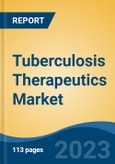Speak directly to the analyst to clarify any post sales queries you may have.
10% Free customizationThis report comes with 10% free customization, enabling you to add data that meets your specific business needs.
Key Market Drivers
High Global Burden of Tuberculosis
The global tuberculosis (TB) burden remains a primary driver of market expansion. WHO data indicates that 10.8 million people contracted TB in 2023, up from 10.7 million in 2022, highlighting a rising trend. This sustained prevalence ensures ongoing demand for both first-line and second-line TB therapies, reinforcing the market's stability. For pharmaceutical companies, this represents a significant opportunity to scale drug portfolios and foster collaborations with public health organizations. The high incidence, particularly in regions with limited healthcare infrastructure, underscores the necessity for scalable treatment solutions, positioning the TB therapeutics market as a reliable avenue for both healthcare impact and commercial returns.Key Market Challenges
Inadequate Funding and Limited Commercial Incentives for Drug Development
The concentration of TB cases in low- and middle-income countries often means that treatment relies on public funding and donor support rather than private investment. This results in limited profitability, discouraging pharmaceutical companies from prioritizing TB drug development. With constrained pricing models, complex regulatory pathways, and minimal patent protection, the return on investment for TB drugs is typically low. Further, the extended timelines of clinical trials and dependency on external funding inhibit innovation. Without enhanced incentives such as co-development frameworks or market guarantees, TB therapeutics are likely to lag behind other disease areas in terms of pharmaceutical innovation.Key Market Trends
Shift Toward Shorter, More Effective Treatment Regimens
There is a growing emphasis on developing shorter, more tolerable TB treatment regimens to improve adherence and outcomes. Novel combinations, such as the 6-month BPaL regimen, are transforming the landscape by reducing the treatment burden compared to traditional 18-24-month protocols. Supported by WHO endorsements and donor-funded initiatives, these advancements are generating increased interest in next-generation therapies. Pharmaceutical companies capable of innovating in fixed-dose combinations and new drug mechanisms stand to benefit from this shift, as these regimens often command higher per-patient value due to better efficacy, reduced side effects, and enhanced patient compliance.Key Market Players
- AstraZeneca PLC
- Johnson & Johnson Services, Inc.
- Eli Lilly and Company
- Mylan Inc.
- Teva Pharmaceutical Industries Ltd
- Sanofi
- Novartis AG
- Sun Pharmaceutical Industries Ltd
- Pfizer Inc.
Report Scope:
In this report, the Global Tuberculosis Therapeutics Market has been segmented into the following categories, in addition to the industry trends which have also been detailed below:Tuberculosis Therapeutics Market, By Disease Type:
- Active TB
- Latent TB
Tuberculosis Therapeutics Market, By Therapy:
- First-Line Therapy
- Second-Line Therapy
Tuberculosis Therapeutics Market, By Route of Administration:
- Oral
- Parenteral
- Others
Tuberculosis Therapeutics Market, By Dosage Form:
- Tablets
- Capsules
- Injection
- Others
Tuberculosis Therapeutics Market, By Distribution Channel:
- Hospital Pharmacy
- Retail Pharmacy
- Online Pharmacy
Tuberculosis Therapeutics Market, By Region:
- North America
- United States
- Canada
- Mexico
- Europe
- France
- United Kingdom
- Italy
- Germany
- Spain
- Asia-Pacific
- China
- India
- Japan
- Australia
- South Korea
- South America
- Brazil
- Argentina
- Colombia
- Middle East & Africa
- South Africa
- Saudi Arabia
- UAE
Competitive Landscape
Company Profiles: Detailed analysis of the major companies present in the Global Tuberculosis Therapeutics Market.Available Customizations:
With the given market data, the publisher offers customizations according to a company's specific needs. The following customization options are available for the report.Company Information
- Detailed analysis and profiling of additional market players (up to five).
This product will be delivered within 1-3 business days.
Table of Contents
Companies Mentioned
- AstraZeneca PLC
- Johnson & Johnson Services, Inc.
- Eli Lilly and Company
- Mylan Inc.
- Teva Pharmaceutical Industries Ltd
- Sanofi
- Novartis AG
- Sun Pharmaceutical Industries Ltd
- Pfizer Inc.
Table Information
| Report Attribute | Details |
|---|---|
| No. of Pages | 180 |
| Published | May 2025 |
| Forecast Period | 2024 - 2030 |
| Estimated Market Value ( USD | $ 2.18 Billion |
| Forecasted Market Value ( USD | $ 2.94 Billion |
| Compound Annual Growth Rate | 5.0% |
| Regions Covered | Global |
| No. of Companies Mentioned | 9 |









